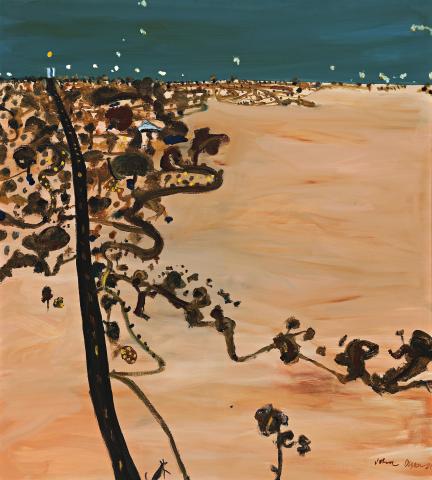MALLEE ROAD TO NHILL I, 1981
JOHN OLSEN
oil on canvas
152.0 x 136.0 cm
signed and dated lower right: John Olsen 81
inscribed with title verso: Mallee Road to Nhill 1
BOC Limited, Sydney
Menzies, Melbourne, 24 September 2015, lot 51
Gould collection, Melbourne
John Olsen’s Mallee Road to Nhill I, 1981 is an evocation which distills the essence of a traveller’s experience through Victoria’s Wimmera region. With the endless tarmac of the Western Highway leading the eye and the arabesque twists of the Wimmera River chiming in, the bustling township of Nhill beckons ‘with a silo like a cathedral dominating the town.’1 Although he had painted the region earlier in the late 1960s, Olsen was now having a far more immersive experience having recently relocated to Clarendon, ‘a small hamlet … in the cleavage of two hills’2, a short drive out of Adelaide. Here, he set up his new studio in the main street in the historic Institute Building dating from 1853. This relocation also triggered regular air travel between his new home and the eastern state capitals of Sydney and Melbourne, meaning the artist experienced elevated views of this landscape, an aspect which further informed his painterly renditions.
In Mallee Road to Nhill I, Olsen emphasises the sparseness of the surrounding land with its innumerable acres of wheat crops ripening in the sun. Low rising scrub appears intermittently as does the occasional fauna, such as the kangaroo on the bottom edge. Olsen’s diary reveals that in early October of 1981, he was spending days ‘drawing, puddling with ink and gouache. I’ve come to love working with a brush, sloppy thick and thin marks, sometimes changing the pace of it with crisp hairy marks.’3 Interestingly, he was also reading correspondence by Sidney Nolan dating from that artist’s own time based in Nhill and nearby Dimboola in the Second World War. During this period, Nolan painted the influential painting Kiata, 1943 which depicts the Western Highway running through this nearby town, not flat as would be expected, but sharply inclined instead, rising up into the horizon. With this one masterly tactic, Nolan revitalised Australia’s landscape painting tradition and Olsen was acutely aware of its significance, going as far as to transcribe text from one of Nolan’s Dimboola letters to Joy Hester, describing ‘the pure mornings here with big gum trees and green parrots flying up from burnt grass… something clean and brittle.’4 Olsen’s diary also records that he was painting three inter-related Mallee paintings that week ‘one with gooky emus staring, which I am not absolutely certain of, two of a single road straight as straight can be, going into a wheat town called appropriately Nhill.’5
The combination of Olsen’s reading, bravura technique and deep philosophical connection to land all come to the fore in Mallee Road to Nhill I. It is a painting which also marks a distinct break from his extended series on Lake Eyre which determined much of the previous decade’s output; but does not discount this period either. Instead, Olsen distilled this outback experience, one infused with the Zen Buddhist ideology of ‘everything and nothingness,’ and in Mallee Road to Nhill I delivered a breakthrough painterly image, one that evokes the artist’s personalised, macro-micro understanding of the pulsating expanses of the Wimmera.
1. Olsen, J., diary entry 9 October 1981, in: Olsen, J., Drawn from Life, Duffy and Snellgrove, Sydney, 1997, p. 157
2. Ward, P., ‘The Un-greening of John Olsen’, Weekend Australian, Sydney, 31 July 1982
3. Olsen. J., diary entry 3 October 1981, in: Olsen, op cit., p. 156
4. Nolan, S., letter to Hester, J., 1943, cited in: Olsen, ibid., p. 156
5. Olsen, J., diary entry 9 October 1981, in: Olsen, ibid., p. 157
ANDREW GAYNOR
